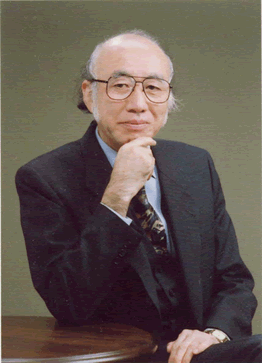KANA
JAPAN
harmonise with infinity
Tetsunosuke Kushida

One of the features unique to Japan is an understanding of nature and musical sounds and how they combine. This understanding of nature can also be found in Japanese art, in particular in the field of literature. We feel a connection with nature, as opposed to looking at it objectively. This is especially true in the case of the haiku – the short Japanese poem, first established by Bashō. The haiku consists of 17 syllables, written in a 5-7-5 form. The haiku reflects our sensitivity to nature and has a musicality that conveys emotion, desire and feeling that is beyond mere words. Through music we can also express this sensitivity to nature. This is the message I wish to convey through my music.
Tetsunosuke Kushida and His Works
Tetsunosuke Kushida was born in Kyoto in 1935.While majoring in mathematics at Kyoto University of Education, he studied composition with Tadashi Fukumoto. After graduation, he continued studies under Nagomi Nakaseko and film-music composer Nakaba Takahashi. He also participated in the group “Tsu-ke-ru, Composers’ Group in Kyoto” and began his wide compositional activities. Kushida was born in a family of Japanese musicians and grew up surrounded by Japanese instruments so his compositional style is generally based on traditional Japanese music.
After he won the Ongaku-no-Tomo-sha Corporation Prize for Composition in 1969 for Stone Garden he studied composition and arranging for brass music under Paul Yoder, ABA first president, and Ichitaro Tsujii, the premiere conductor for Asuka. Tsujii has been a major influence on Kushida’s works for brass. Asuka was recorded by Tokyo Kosei Wind Orchestra and judging from its frequent performance both in Japan and foreign countries, it can be said that the piece has entered major repertory status.
Kushida has produced many works with Japanese historical inspiration, which include Collage for Band – on Folk Songs from the Tohoku District, Clouds in Collage, Ritual Legend, Snow-Moon-Flower, Sagano, Kagerohi (“Shimmering Air”), and The Clouds Add Colors. He has also written many work for wind instruments, which include works for recitals by Kenji Munesada, Kenji Shimoji and Masahiro Maeda, and works for saxophone ensembles.
In 1995, he was awarded the 5th Academy Award, Wind Music Japan. In the same year, his work Autumn in Heian-Kyo was premiered by Baden Württemberg Wind Ensemble. He was also invited as a special guest professor to Osaka College of Music and gave a lecture under the title of “Japanese Traditional Music and Brass Music.” In March 1997, he presented a lecture and concert under the same title in Hiroshima and Okayama, in collaboration with the Symphonic Wind Orchestra of Nagoya University of Arts.
A collaboration with Kohei Amada (sculptor, koto player and harpist) and his son Koji Amada (harpist) was to lead Kushida into a definite direction in terms of his view of the Japanese sound and Japanese music. Kohei Amada also was a tremendous influence on his life, as well as his music. His recent piece Quiet Side Path for Harp Ensemble and Narrator , performed in the memorial concert for Kohei Amada by the Amada Ensemble under Koji Amada , with Fujio Tokita narrating, strongly reflects his view of life. Many of his works for harp ensemble, such as Night in the Glass, Ondine’s Night, and Omohi (“Thoughts”), performed at the Fukui International Harp Festival, have been programmed repeatedly in foreign countries as well as in Japan, and have become favorite pieces.
Seeking broader activities as a composer, Kushida has also been working on perusing the creativity of “Structural Art” (art as multimedia ), which unifies a variety of fields such as paintings, architecture, photography and film. He has also been very active as an event and sound coordinator, surpassing the boundaries of his activities as a composer, arranger and conductor. He participated in establishing the Music Projects Kyoto “Gosho-no-Mori,” a center for musical activities, and has been serving as Vice President. He currently teaches at the Faculty of Literature and Education of Kyoto Women's College and Academy Concert Kyoto.